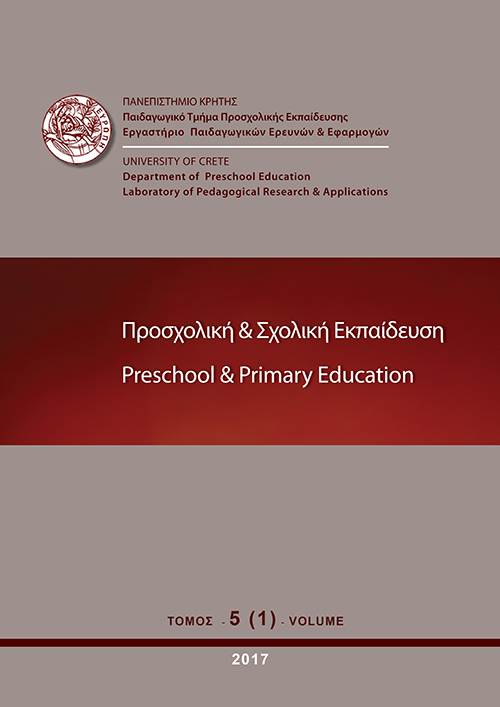Εκφοβισμός και θυματοποίηση: Βιβλιογραφική ανασκόπηση ερευνητικών ευρημάτων από τον ελληνικό χώρο

Περίληψη
Η παρούσα ανασκόπηση αποσκοπεί στην πληρέστερη κατανόηση των παραγόντων που συνδέονται με την εκδήλωση του παραδοσιακού εκφοβισμού και του κυβερνο-εκφοβισμού/θυματοποίησης (ΠΕ, ΚΕ, ΠΘ, ΚΘ) σε έλληνες μαθητές προεφηβικής και εφηβικής ηλικίας. Συγκεκριμένα, επιχειρείται η κριτική ανάλυση και συνθετική παρουσίαση πορισμάτων ερευνών, που πραγματοποιήθηκαν από τον πρώτο συγγραφέα και την ερευνητική του ομάδα και που δημοσιεύονται σε ξενόγλωσσα επιστημονικά περιοδικά, στη βάση του θεωρητικού πλαισίου του Γενικού Μοντέλου Επιθετικότητας (ΓΜΕ). Αρχικά, γίνεται σύνθεση ευρημάτων σχετικών με ατομικούς παράγοντες καθώς και με τους παράγοντες πλαισίου που συνδέονται με την εκδήλωση/βίωση τέτοιου είδους εμπειριών. Στη συνέχεια, αναλύονται τα ευρήματα για τους μηχανισμούς εσωτερικής/ψυχικής κατάστασης (διαδικασίες κοινωνικής επεξεργασίας/νόησης) που φαίνεται να συνδέονται με τους προαναφερθέντες παράγοντες και οι οποίοι μπορούν να οδηγήσουν σε εμπειρίες ΠΕ/ΠΘ και ΚΕ/ΚΘ. Ακολουθούν οι διαδικασίες αξιολόγησης, επαναξιολόγησης (στρατηγικές διαχείρισης ψυχοπιεστικών καταστάσεων) και λήψης απόφασης, που έπονται των διεργασιών εσωτερικής/ψυχικής κατάστασης. Αναφορά γίνεται επίσης σε πιθανές μακροπρόθεσμες επιπτώσεις των εμπειριών ΠΕ/ΠΘ και ΚΕ/ΚΘ στο άτομο. Συνολικά, η παρούσα εργασία παρέχει ενδείξεις πως ορισμένοι ατομικοί και καταστασιακοί παράγοντες ενδέχεται να συνδέονται μέσω συγκεκριμένων διεργασιών, συμβατών με αυτούς που περιγράφονται από το ΓΜΕ, με την εκδήλωση/βίωση των εν λόγω φαινομένων. Ωστόσο, αναδεικνύονται ορισμένες διαδραστικές σχέσεις μεταξύ ενδοπροσωπικών, νοητικών και συναισθηματικών παραγόντων, που δε φαίνεται να λαμβάνονται υπόψη από το ΓΜΕ. Στο τέλος του άρθρου παρατίθενται οι περιορισμοί της παρούσας ανασκόπησης, καθώς και ορισμένες προτάσεις για μελλοντική έρευνα.
Λεπτομέρειες άρθρου
- Πώς να δημιουργήσετε Αναφορές
-
Kokkinos, K. M., & Karagianni, K. (2017). Εκφοβισμός και θυματοποίηση: Βιβλιογραφική ανασκόπηση ερευνητικών ευρημάτων από τον ελληνικό χώρο. Preschool and Primary Education, 5(1), 2–45. https://doi.org/10.12681/ppej.10630
- Τεύχος
- Τόμ. 5 Αρ. 1 (2017)
- Ενότητα
- Άρθρα

Αυτή η εργασία είναι αδειοδοτημένη υπό το CC Αναφορά Δημιουργού – Μη Εμπορική Χρήση – Παρόμοια Διανομή 4.0.
Οι συγγραφείς των άρθρων που δημοσιεύονται στο ΠΡΟΣΧΟΛΙΚΗ & ΣΧΟΛΙΚΗ ΕΚΠΑΙΔΕΥΣΗ διατηρούν τα δικαιώματα πνευματικής ιδιοκτησίας επί των άρθρων τους, δίνοντας στο περιοδικό το δικαίωμα της πρώτης δημοσίευσης. Άρθρα που δημοσιεύονται στο ΠΡΟΣΧΟΛΙΚΗ & ΣΧΟΛΙΚΗ ΕΚΠΑΙΔΕΥΣΗ διατίθενται με άδεια Creative Commons 3.0 και σύμφωνα με την άδεια μπορούν να χρησιμοποιούνται ελεύθερα, με αναφορά στο/στη συγγραφέα και στην πρώτη δημοσίευση για μη κερδοσκοπικούς σκοπούς και με δικαίωμα τροποποίησης μόνον με παρόμοια διανομή (αν αναμείξετε, τροποποιήσετε, ή δημιουργήσετε πάνω στο υλικό, πρέπει να διανείμετε τις δικές σας συνεισφορές υπό την ίδια άδεια όπως και το πρωτότυπο). To Εργαστήριο Παιδαγωγικών Ερευνών και Εφαρμογών του Παιδαγωγικού Τμήματος Προσχολικής Εκπαίδευσης του Πανεπιστημίου Κρήτης και το Εθνικό Κέντρο Τεκμηρίωσης διατηρούν το δικαίωμα να δημοσιεύουν, να αναπαραγάγουν, να παρουσιάζουν στο κοινό, να διανέμουν και χρησιμοποιούν άρθρα που δημοσιεύονται στο ΠΡΟΣΧΟΛΙΚΗ & ΣΧΟΛΙΚΗ ΕΚΠΑΙΔΕΥΣΗ σε οποιοδήποτε μέσο και μορφή είτε μεμονωμένα είτε ως μέρη συλλογικών έργων, για όλο το χρόνο διάρκειας προστασίας της πνευματικής ιδιοκτησίας και για όλες τις χώρες του κόσμου. Αυτό περιλαμβάνει ενδεικτικά και όχι αποκλειστικά, το δικαίωμα δημοσίευσης των άρθρων σε τεύχη του περιοδικού ΠΡΟΣΧΟΛΙΚΗ & ΣΧΟΛΙΚΗ ΕΚΠΑΙΔΕΥΣΗ, αναπαραγωγής και διανομής μεμονωμένων αντιγράφων των άρθρων, αναπαραγωγής ολόκληρων των άρθρων σε άλλη έκδοση του Εργαστηρίου Παιδαγωγικών Ερευνών και Εφαρμογών του Παιδαγωγικού Τμήματος Προσχολικής Εκπαίδευσης του Πανεπιστημίου Κρήτης και του Εθνικού Κέντρου Τεκμηρίωσης και αναπαραγωγής και διανομής των άρθρων ή περίληψης αυτών με χρήση πληροφορικού συστήματος αποθετηρίου.


